3885 S. Decatur Blvd Suite #1080
Las Vegas, NV 89103
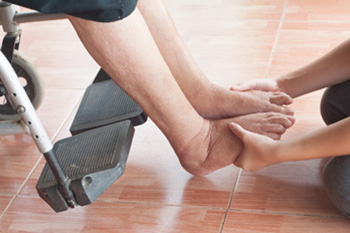
Foot and ankle problems are prevalent medical issues, particularly among the elderly, who often suffer from pain, stiffness, swelling, or deformities. Common diagnoses include conditions such as corns, athlete's foot, bunions, flat feet, ingrown nails, and warts. Aging-related muscle mass and loss of bone strength may increase seniors' risk for injuries and fractures, compounded by balance and vision issues. Key foot and ankle injuries in the elderly include ankle sprains, where the ligaments are overstretched or torn, potentially weakening the ankle and leading to arthritis, if untreated. Achilles tendonitis and tears are also common. The Achilles is vulnerable to inflammation and overuse, which can escalate to tears or ruptures, especially with sudden trauma. Ankle fractures are serious injuries from traumatic impact, requiring immediate podiatric attention to prevent complications such as infections. The spectrum of foot and ankle injuries in the elderly ranges from minor, treatable conditions to severe injuries necessitating medical intervention, highlighting the need for attentive care to prevent these issues. If you are elderly and have foot or ankle problems, it is suggested that you make an appointment with a podiatrist for a proper diagnosis and treatment.
Ankle pain can have many different causes and the pain may potentially be serious. If you have ankle pain, consult with Loren Hansen, DPM from Ankle & Foot Medical Center. Our doctor will assess your condition and provide you with quality foot and ankle treatment.
Ankle pain is any condition that causes pain in the ankle. Due to the fact that the ankle consists of tendons, muscles, bones, and ligaments, ankle pain can come from a number of different conditions.
Causes
The most common causes of ankle pain include:
Symptoms
Symptoms of ankle injury vary based upon the condition. Pain may include general pain and discomfort, swelling, aching, redness, bruising, burning or stabbing sensations, and/or loss of sensation.
Diagnosis
Due to the wide variety of potential causes of ankle pain, podiatrists will utilize a number of different methods to properly diagnose ankle pain. This can include asking for personal and family medical histories and of any recent injuries. Further diagnosis may include sensation tests, a physical examination, and potentially x-rays or other imaging tests.
Treatment
Just as the range of causes varies widely, so do treatments. Some more common treatments are rest, ice packs, keeping pressure off the foot, orthotics and braces, medication for inflammation and pain, and surgery.
If you have any questions, please feel free to contact our office located in Las Vegas, NV . We offer the newest diagnostic and treatment technologies for all your foot care needs.
Pain experienced in the ankle can be caused by a multitude of conditions. While the most common cause is an ankle sprain, other possible problems can include arthritis, gout, ankle instability, an ankle fracture, nerve compression, or tendinitis. In more serious cases, ankle pain can be a sign of improper alignment of the foot or an infection.
Ankle pain can often be accompanied by symptoms such as redness, swelling, stiffness, and warmth in the affected area. Pain can be described differently depending on the condition: short, stabbing pain and a dull ache are some examples. If such symptoms are persistent and do not improve after time, be sure to schedule an appointment with your local podiatrist.
Depending on the condition causing your ankle pain, different treatments may be prescribed by your podiatrist. For ankle sprains, the first step in treatment involves rest, ice, elevation, and compression. Be sure to avoid placing pressure on the ankle, use an ice pack several times a day, and use a compression bandage and elevation to reduce swelling. Other, more serious conditions may require the assistance of certain drugs and medications such as nonsteroidal anti-inflammatory drugs (NSAIDs), physical therapy, or even cortisone injections.
Depending on the severity of your ankle pain and the condition behind it, recovery from ankle pain may take some time.
Consult with your foot and ankle doctor to best determine the cause of your ankle pain and the appropriate treatment.
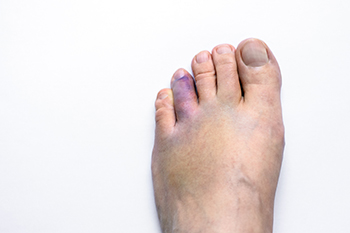
A broken toe, or toe fracture, is a painful injury that occurs when one or more of the toe bones known as the phalanges become cracked or fractured. This injury typically results from a sudden and forceful impact or trauma, like dropping a heavy object on the toe, stubbing it, or experiencing a direct blow during sports or accidents. The symptoms of a broken toe are quite distinct. Severe pain and immediate discomfort are common, often accompanied by swelling, bruising, and tenderness around the affected area. The toe may appear misshapen or out of alignment, making it challenging to move or bear weight. If the broken toe is severe, some individuals hear a cracking or popping sound at the time of injury. It is crucial to seek medical attention from a podiatrist if you suspect a broken toe. Recognizing the signs and seeking timely care can help prevent complications and expedite the recovery process. If you have broken your toe, it is suggested that you contact this type of doctor who can perform an accurate diagnosis and guide you toward the appropriate treatment method.
Broken toes may cause a lot of pain and should be treated as soon as possible. If you have any concerns about your feet, contact Loren Hansen, DPM from Ankle & Foot Medical Center. Our doctor will treat your foot and ankle needs.
What Is a Broken Toe?
A broken toe occurs when one or more of the toe bones of the foot are broken after an injury. Injuries such as stubbing your toe or dropping a heavy object on it may cause a toe fracture.
Symptoms of a Broken Toe
Although the injured toe should be monitored daily, it is especially important to have a podiatrist look at your toe if you have severe symptoms. Some of these symptoms include worsening or new pain that is not relieved with medication, sores, redness, or open wounds near the toe.
If you have any questions, please feel free to contact our office located in Las Vegas, NV . We offer the newest diagnostic and treatment technologies for all your foot care needs.
The forefoot is composed of five metatarsal bones and fourteen phalanges. Each toe has three phalanges except for the big toe which only has two. Our toes play an essential role to the walking process, which is why a broken toe could seriously disrupt one’s ability to move around. Toe fractures are common and can be very painful. Fortunately, these injuries rarely require surgery and usually heal with rest and a change in activity.
Broken toes typically result from a traumatic event such as falling, stubbing the toe, or dropping something on the toe. Traumatic toe fractures may be categorized as either minor or severe fractures. At times, one may hear a “pop” or “crack” sound when the bone breaks. Common symptoms of a traumatic toe fracture include pain, throbbing, bruising, swelling, and redness.
Another type of toe fractures is a stress fracture. These injuries usually appear in the form of small hairline breaks on the bone. Stress fractures develop after repetitive activity instead of a single injury. Stress fractures occur when the muscles in the bone become too weak to absorb impact. Consequently, the toe bone becomes vulnerable to any pressure and impact it endures. Symptoms for a stress fracture in the toe include swelling without bruising, tenderness to the touch, pain that goes away with rest, and pain after walking or running.
If you suspect that you have a broken toe, you should make an appointment with your podiatrist. He or she will likely diagnose you by performing a physical exam and an X-ray. Treatment for a broken toe may include the R.I.C.E. method, buddy taping, surgery, or antibiotics. The R.I.C.E. method (Rest, Ice, Compression, and Elevation) is a common treatment method for many injuries because it decreases pain. Buddy tapping involves wrapping the injured toe next to an adjacent toe to keep it supported and protected. These two methods have proven to be effective in the healing process for toe fractures. The estimated healing time for a broken toe is approximately four to six weeks. If the injury becomes infected or requires surgery, the estimated healing time may take eight weeks or more.
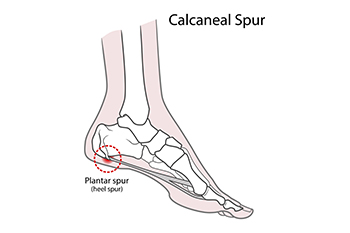
A heel spur is a common foot condition that is often discussed in the context of heel pain and discomfort. Despite their reputation, they are not actually sharp, pointy growths, as the term may imply. Instead, heel spurs are calcium deposits that form on the underside of the heel bone. These deposits often develop over an extended period of time due to chronic inflammation or stress on the plantar fascia, the band of tissue that connects the heel to the toes. The primary characteristic of heel spurs is the accompanying pain. This discomfort is often described as a sharp, stabbing sensation, particularly with the first steps in the morning or after prolonged periods of rest. It is important to note that not everyone with heel spurs experiences pain, as many people have them without any symptoms. The causes of heel spurs are diverse, with factors such as obesity, gait abnormalities, or wearing inadequate footwear contributing significantly. Heel spurs are a condition that is often linked to heel pain, but they are generally not the sole cause. If you are experiencing persistent heel pain, it is suggested that you consult a podiatrist, who can accurately diagnose and treat heel spurs if they are the culprit.
Heel spurs can be incredibly painful and sometimes may make you unable to participate in physical activities. To get medical care for your heel spurs, contact Loren Hansen, DPM from Ankle & Foot Medical Center. Our doctor will do everything possible to treat your condition.
Heels Spurs
Heel spurs are formed by calcium deposits on the back of the foot where the heel is. This can also be caused by small fragments of bone breaking off one section of the foot, attaching onto the back of the foot. Heel spurs can also be bone growth on the back of the foot and may grow in the direction of the arch of the foot.
Older individuals usually suffer from heel spurs and pain sometimes intensifies with age. One of the main condition's spurs are related to is plantar fasciitis.
Pain
The pain associated with spurs is often because of weight placed on the feet. When someone is walking, their entire weight is concentrated on the feet. Bone spurs then have the tendency to affect other bones and tissues around the foot. As the pain continues, the feet will become tender and sensitive over time.
Treatments
There are many ways to treat heel spurs. If one is suffering from heel spurs in conjunction with pain, there are several methods for healing. Medication, surgery, and herbal care are some options.
If you have any questions feel free to contact our office located in Las Vegas, NV . We offer the latest in diagnostic and treatment technology to meet your needs.
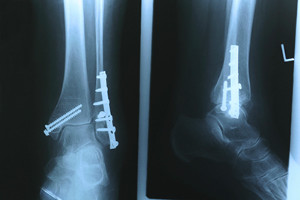
Stress fractures are tiny, gradual bone cracks caused by overuse or repetitive activities, common in athletes. Unlike sudden regular fractures, they develop over time, often affecting the feet and lower limbs. Risk factors include excessive stress, hard surfaces, and rapid changes in exercise intensity. Other causes are weak muscles, joint issues, osteoporosis, medications, poor footwear, and vitamin deficiencies. Symptoms include localized pain, swelling, tenderness, and discomfort during high-impact activities. Diagnosis involves a physical assessment, potentially followed by an X-ray or MRI. Treatment includes rest, compression, training modification, and low-impact activities. Supportive footwear, custom foot orthotics, anti-inflammatories, and exercises can also help. Surgery may be needed in severe cases. Ignoring stress fractures can lead to complete fractures, non-healing, bone necrosis, and surgery. If you are experiencing foot or ankle pain, it is strongly suggested that you make an appointment with a podiatrist who can properly diagnose the issue and provide treatment options.
Activities where too much pressure is put on the feet can cause stress fractures. To learn more, contact Loren Hansen, DPM from Ankle & Foot Medical Center. Our doctor can provide the care you need to keep your pain free and on your feet.
Dealing with Stress Fractures of the Foot and Ankle
Stress fractures occur in the foot and ankle when muscles in these areas weaken from too much or too little use. The feet and ankles then lose support when walking or running from the impact of the ground. Since there is no protection, the bones receive the full impact of each step. Stress on the feet can cause cracks to form in the bones, thus creating stress fractures.
What Are Stress Fractures?
Stress fractures occur frequently in individuals whose daily activities cause great impact on the feet and ankles. Stress factors are most common among:
Symptoms
Pain from the fractures occur in the area of the fractures and can be constant or intermittent. It will often cause sharp or dull pain with swelling and tenderness. Engaging in any kind of activity which involves high impact will aggravate pain.
If you have any questions please feel free to contact our office located in Las Vegas, NV . We offer the newest diagnostic and treatment technologies for all your foot and ankle needs.

When it comes to marathon running, a grueling 26.2-mile journey, selecting the ideal pair of running shoes can significantly affect your performance and overall foot health, as well as prevent injury. Here are some essential features to consider when choosing your marathon running shoes. Cushioning plays a vital role in marathon shoes. Select shoes with adequate midsole cushioning to absorb the shock generated by each stride. Arch support for proper foot alignment is essential to prevent overpronation or supination, either of which can lead to discomfort and potential injuries. Breathability is important, as running for extended periods can result in sweaty feet, which may lead to discomfort, infection, and even blisters. The weight of marathon shoes cannot be ignored. The lighter the shoe, the less fatigue your legs will experience over the long distance. Lastly, durability should not be underestimated. Marathon training and racing can put your shoes through significant wear and tear. To ensure your shoes last the distance, select pairs constructed from high-quality materials designed to withstand the rigors of marathon running. For additional help with selecting the right running shoes, it is suggested that you consult a podiatrist.
If you are a runner, wearing the right running shoe is essential. For more information, contact Loren Hansen, DPM from Ankle & Foot Medical Center. Our doctor can provide the care you need to keep you pain-free and on your feet.
Choosing the Right Running Shoe for Your Foot Type
To increase performance and avoid the risk of injury, it is important to choose the right running shoe based on your foot type. The general design of running shoes revolves around pronation, which is how the ankle rolls from outside to inside when the foot strikes the ground.
If you have any questions please feel free to contact our office located in Las Vegas, NV . We offer the newest diagnostic and treatment technologies for all your foot and ankle needs.
Running may seem like a simple to do. However, running is actually a complex movement that puts stress on the ligaments, bones, and joints of the body. Selecting the correct running shoe is important for increasing performance and avoiding risk of injury. Running shoes should be selected based on your foot type. Considerations such as trail versus road shoes are important. Your foot type dictates the degree of cushioning, stability and motion control you require. The most accurate way to learn your foot type is to visit a local shop that specializes in running shoes. Professionals can measure your arch type, stride and gait and help you with your shoe needs.
The design of running shoes is created around the idea of pronation. Pronation is the natural rolling movement of your ankle from the outside to inside when your foot strikes the ground. If you run properly you strike the ground on the outside of your heel and roll in the direction of your big toe before pushing off once more. Pronation is beneficial because it assists the lower half of your body in absorbing shock and storing energy. Those considered neutral runners pronate correctly and do not need running shoes that help correct their form. Neutral runners can choose from a wide variety of shoes, including barefoot or minimal types. However, those who have arch problems or who adopt an incorrect form while running may experience too much or too little pronation. They may require running shoes that offer additional support.
Those who overpronate experience an over-abundance of ankle rolling. Even while standing, those who severely overpronate display ankles that are angled inward. It is not uncommon for them to have flat feet or curved legs. The tendency to overpronate may cause many injuries. Areas that tend to become injured are the knees, ankles, and Achilles tendon. If you find that you have a tendency to overpronate, you should look at shoes that provide extra stability and motion-control. Motion-control shoes are straight and firm. Shoes of this type do not curve at the tip. The restricted flexibility along the middle of the shoe prohibits the foot from rolling too far inward as your foot strikes the ground.
A less common problem is underpronation. Underpronation, also called supination, is when the feet are unable to roll inward during landing. Those who underpronate have feet that lack flexibility and high arches. This prevents any kind of shock absorption, even though it does place less rotational stress on ankles and knees. This added force can cause fractures, ligament tears, and muscle strains because the legs are trying to compensate for the impact. Those who underpronate need shoes with more cushioning and flexibility. If you have a tendency to underpronate, selecting stability or motion-control shoes may cause you more problems by continuing to prevent pronation.

Cracked heels, a common foot ailment, can be both unsightly and uncomfortable. These painful fissures occur when the skin on the heels becomes dry and thick, and loses its natural elasticity. While cracked heels may seem like a cosmetic concern, ignoring them can lead to infection or more severe issues if left untreated. Several factors contribute to the development of cracked heels. The primary cause is inadequate moisture, often made worse by dry weather, excessive foot soaking, or harsh soaps that strip the skin of its natural oils. Overweight individuals and those who stand for prolonged periods may also be more susceptible due to increased pressure on the heels. Treating cracked heels involves a multifaceted approach. Hydration is key, so moisturize your feet regularly with a thick, emollient foot cream. Exfoliate gently using a pumice stone to remove dead skin. Wear comfortable, well-fitting shoes with proper arch support to alleviate pressure. If you have developed cracked heels, it is suggested that you consult a podiatrist who may recommend prescription creams or therapies to address underlying issues.
Cracked heels are unsightly and can cause further damage to your shoes and feet. If you have any concerns, contact Loren Hansen, DPM from Ankle & Foot Medical Center. Our doctor can provide the care you need to keep you pain-free and on your feet.
Cracked Heels
Cracked heels appear unappealing and can make it harder for you walk around in sandals. Aside from looking unpleasant, cracked heels can also tear stockings, socks, and wear out your shoes. There are several methods to help restore a cracked heel and prevent further damage.
How Do You Get Them?
Dry skin is the number one culprit in creating cracked heels. Many athletes, walkers, joggers, and even swimmers suffer from cracked heels. Age and skin oil production play a role to getting cracked heels as well.
Promote Healing
Over the counter medicines can help, especially for those that need instant relief or who suffer from chronic dry feet.
Wear Socks – Wearing socks with medicated creams helps lock in moisture.
Moisturizers – Applying both day and night will help alleviate dryness which causes cracking.
Pumice Stones – These exfoliate and remove dead skin, which allows for smoother moisturizer application and better absorption into the skin.
Change in Diet
Eating healthy with a well-balanced diet will give the skin a fresh and radiant look. Your body responds to the kinds of food you ingest. Omega-3 fatty acids and zinc supplements can also revitalize skin tissue.
Most importantly, seek professional help if unsure how to proceed in treating cracked heels. A podiatrist will help you with any questions or information needed.
If you have any questions, please feel free to contact our office located in Las Vegas, NV . We offer the newest diagnostic and treatment technologies for all your foot care needs.
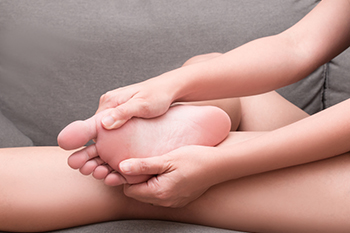
Sesamoiditis is a condition that affects the sesamoid bones, which are located under the base of the big toe. These bones, enclosed within tendons, can become inflamed due to an acute injury or chronic overuse. Other possible causes of this affliction include stress fractures, infection, or autoimmune disorders. Symptoms often include pain during walking, or when forcefully pulling the big toe upwards, causing pressure on the sesamoid bones. Relief may come from wearing shoes with adequate cushioning, using shoe inserts or orthotics, rest, and taking anti-inflammatory medication. If more conservative treatments are not successful, surgery may be an option. If you have pain in your big toe, it is suggested that you make an appointment with a podiatrist for a proper diagnosis and treatment.
Sesamoiditis is an unpleasant foot condition characterized by pain in the balls of the feet. If you think you’re struggling with sesamoiditis, contact Loren Hansen, DPM of Ankle & Foot Medical Center. Our doctor will treat your condition thoroughly and effectively.
Sesamoiditis
Sesamoiditis is a condition of the foot that affects the ball of the foot. It is more common in younger people than it is in older people. It can also occur with people who have begun a new exercise program, since their bodies are adjusting to the new physical regimen. Pain may also be caused by the inflammation of tendons surrounding the bones. It is important to seek treatment in its early stages because if you ignore the pain, this condition can lead to more serious problems such as severe irritation and bone fractures.
Causes of Sesamoiditis
Treatment for sesamoiditis is non-invasive and simple. Doctors may recommend a strict rest period where the patient forgoes most physical activity. This will help give the patient time to heal their feet through limited activity. For serious cases, it is best to speak with your doctor to determine a treatment option that will help your specific needs.
If you have any questions please feel free to contact our office located in Las Vegas, NV . We offer the newest diagnostic and treatment technologies for all your foot and ankle needs.